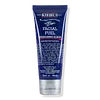What's inside
What's inside
 Key Ingredients
Key Ingredients

 Benefits
Benefits

 Concerns
Concerns

 Ingredients Side-by-side
Ingredients Side-by-side

Water
Skin ConditioningHelianthus Annuus Hybrid Oil
EmollientCetyl Alcohol
EmollientArgania Spinosa Shell Powder
AbrasiveBehenyl Alcohol
EmollientGlyceryl Stearate Citrate
EmollientAstrocaryum Murumuru Seed Butter
EmollientBrassica Campestris Seed Oil
Skin ConditioningTocopherol
AntioxidantCistus Monspeliensis Extract
MaskingStevia Rebaudiana Extract
Benzyl Alcohol
PerfumingCitric Acid
BufferingSodium Hydroxide
BufferingXanthan Gum
EmulsifyingGlycine Soja Oil
EmollientDehydroacetic Acid
PreservativePolyglyceryl-3 Diisostearate
EmulsifyingWater, Helianthus Annuus Hybrid Oil, Cetyl Alcohol, Argania Spinosa Shell Powder, Behenyl Alcohol, Glyceryl Stearate Citrate, Astrocaryum Murumuru Seed Butter, Brassica Campestris Seed Oil, Tocopherol, Cistus Monspeliensis Extract, Stevia Rebaudiana Extract, Benzyl Alcohol, Citric Acid, Sodium Hydroxide, Xanthan Gum, Glycine Soja Oil, Dehydroacetic Acid, Polyglyceryl-3 Diisostearate
Water
Skin ConditioningMyristic Acid
CleansingPalmitic Acid
EmollientPerlite
AbsorbentPotassium Hydroxide
BufferingLauric Acid
CleansingStearic Acid
CleansingPEG-7 Glyceryl Cocoate
EmulsifyingPrunus Armeniaca Seed Powder
AbrasiveDisodium Cocoyl Glutamate
CleansingGlycerin
HumectantSodium Lauroyl Glutamate
Phenoxyethanol
PreservativeCeteareth-60 Myristyl Glycol
EmulsifyingSodium Hydroxide
BufferingArgilla
AbrasiveCitric Acid
BufferingSodium Cocoyl Glutamate
CleansingCaprylyl Glycol
EmollientPentaerythrityl Tetra-Di-T-Butyl Hydroxyhydrocinnamate
AntioxidantDisodium EDTA
Parfum
MaskingMenthol
MaskingCaffeine
Skin ConditioningLimonene
PerfumingGlycine Soja Oil
EmollientTocopherol
AntioxidantCastanea Sativa Seed Extract
Skin ConditioningPentylene Glycol
Skin ConditioningHydrolyzed Soy Protein
HumectantCitrus Aurantium Dulcis Juice
Skin ConditioningCitrus Limon Juice
Skin ConditioningSodium Benzoate
MaskingPotassium Sorbate
PreservativeEthylhexylglycerin
Skin ConditioningWater, Myristic Acid, Palmitic Acid, Perlite, Potassium Hydroxide, Lauric Acid, Stearic Acid, PEG-7 Glyceryl Cocoate, Prunus Armeniaca Seed Powder, Disodium Cocoyl Glutamate, Glycerin, Sodium Lauroyl Glutamate, Phenoxyethanol, Ceteareth-60 Myristyl Glycol, Sodium Hydroxide, Argilla, Citric Acid, Sodium Cocoyl Glutamate, Caprylyl Glycol, Pentaerythrityl Tetra-Di-T-Butyl Hydroxyhydrocinnamate, Disodium EDTA, Parfum, Menthol, Caffeine, Limonene, Glycine Soja Oil, Tocopherol, Castanea Sativa Seed Extract, Pentylene Glycol, Hydrolyzed Soy Protein, Citrus Aurantium Dulcis Juice, Citrus Limon Juice, Sodium Benzoate, Potassium Sorbate, Ethylhexylglycerin
Ingredients Explained
These ingredients are found in both products.
Ingredients higher up in an ingredient list are typically present in a larger amount.
Citric Acid is an alpha hydroxy acid (AHA) naturally found in citrus fruits like oranges, lemons, and limes.
Like other AHAs, citric acid can exfoliate skin by breaking down the bonds that hold dead skin cells together. This helps reveal smoother and brighter skin underneath.
However, this exfoliating effect only happens at high concentrations (20%) which can be hard to find in cosmetic products.
Due to this, citric acid is usually included in small amounts as a pH adjuster. This helps keep products slightly more acidic and compatible with skin's natural pH.
In skincare formulas, citric acid can:
While it can provide some skin benefits, research shows lactic acid and glycolic acid are generally more effective and less irritating exfoliants.
Most citric acid used in skincare today is made by fermenting sugars (usually from molasses). This synthetic version is identical to the natural citrus form but easier to stabilize and use in formulations.
Read more about some other popular AHA's here:
Learn more about Citric AcidGlycine Soja Oil comes from the soybean. Glycine Soja is native to eastern Asia.
Soybean oil is an emollient. It is rich in antioxidants and fatty acids including palmitic, stearic, oleic, and linoleic acids.
As an emollient, the fatty acids in soybean oil helps keep your skin soft and hydrated. It does so by creating a film on top that traps moisture in.
Soybean oil is also rich in vitamin E, a potent antioxidant. Vitamin E is also anti-inflammatory and provides a soothing effect.
Studies show soy may help fade hyperpigmentation from UVB. It does so by disrupting the melanin process from UVB induced skin inflammation.
This ingredient may not be malassezia folliculitis, or fungal-acne, safe.
Soybeans are rich in proteins and are part of the legume family. Foods made with soybeans include tofu, soymilk, edamame, miso, and soy sauce.
Learn more about Glycine Soja OilSodium Hydroxide is also known as lye or caustic soda. It is used to adjust the pH of products; many ingredients require a specific pH to be effective.
In small amounts, sodium hydroxide is considered safe to use. However, large amounts may cause chemical burns due to its high alkaline.
Your skin has a natural pH and acid mantle. This acid mantle helps prevent harmful bacteria from breaking through. The acid mantle also helps keep your skin hydrated.
"Alkaline" refers to a high pH level. A low pH level would be considered acidic.
Learn more about Sodium HydroxideTocopherol (also known as Vitamin E) is a common antioxidant used to help protect the skin from free-radicals and strengthen the skin barrier. It's also fat soluble - this means our skin is great at absorbing it.
Vitamin E also helps keep your natural skin lipids healthy. Your lipid skin barrier naturally consists of lipids, ceramides, and fatty acids. Vitamin E offers extra protection for your skin’s lipid barrier, keeping your skin healthy and nourished.
Another benefit is a bit of UV protection. Vitamin E helps reduce the damage caused by UVB rays. (It should not replace your sunscreen). Combining it with Vitamin C can decrease sunburned cells and hyperpigmentation after UV exposure.
You might have noticed Vitamin E + C often paired together. This is because it is great at stabilizing Vitamin C. Using the two together helps increase the effectiveness of both ingredients.
There are often claims that Vitamin E can reduce/prevent scarring, but these claims haven't been confirmed by scientific research.
Learn more about TocopherolWater. It's the most common cosmetic ingredient of all. You'll usually see it at the top of ingredient lists, meaning that it makes up the largest part of the product.
So why is it so popular? Water most often acts as a solvent - this means that it helps dissolve other ingredients into the formulation.
You'll also recognize water as that liquid we all need to stay alive. If you see this, drink a glass of water. Stay hydrated!
Learn more about Water